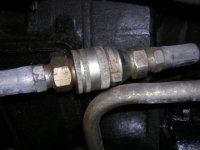As chip said, don't run with the quick connects seperated, the hydraulic oil must flow or things get ugly real quick. Another good suggestion is to place a large ty-wrap around the larger female quick connect locking the sliding collar in position. This will prevent a piece of wood/brush(or someone who dosn't know better) from accidentally separating the quick connect.
There have been a few people on here who have had problems getting the hydraulics to prime. These things are designed to pump fluid, not air. If they are completely dry, they cant pull the fluid up and over the top to get it out of the resovoir. When I changed out the fluids in my 284, when completed and with the coupling on top of the resovoir still seperated, I used a automatic transmission funnel(has on-off valve and hose) to put AW32 hydraulic fluid down the supply pipe to the pump till it was full of fluid. I then tightened up the coupling on top of the resovoir and started the tractor. It drew fluid from the resovoir immediatly. That coupling on top of the resovoir was loose on mine when delivered. If yours is loose, it could easilly be sucking air into the system. This would also cause erratic operation as it did with mine.
As for draining and flushing, you can get quite a lot of the fluid out of the system by shutting the tractor down with the front axel on jackstands and the loader at full height with bucket rolled all the way back. It is best to have the front raised anyway to facilitate the hydraulic resovoir draining out the back. Once shut down, start draining the resovoir then open the union on top of the resovoir(under the front of the seat). Once the resovoir has drained down some, allow the bucket to dump all the way forward to empty the other half of those cylinders. Once this is done, lower the loader arms till the bucket is down on the ground. This will force most of the rest of the oil out of those cylinders and back to the resovoir. Once the bucket is down and safe on the ground, if you have power steering, use the steering wheel and someone else pushing on the front wheel to run the steering back and forth through full travel. This will force most of the fluid out of the steering cylinder and back to the resovoir. About all that will not make it out of the system is what is left in the lines. When you refill, this will leave a very low precentage of original fluid in the system. If you drain and refill a second time after running and cycling the system for a while, the precentage of original fluid in the system will be very very small.
Some reccomend refilling the system with kerosene and cycling the system and draining. Any kero left after that drain will ultimatly evaporate. At the very least, while the resovoir is drained, use a syringe and hose to suck out all the old hyd fluid left in the resovoir cavities and rinse the resovoir throughly with kerosene. You will most likley discover a very large ammount of fine metal shavings in the bottom of the resovoir(I sure did).
Inspect the strainer carefully, mine was loose and had a hole in it as delivered. I was not really impressed with the stock strainer, the top plate on mine wasn't even straight so it didn't fit together real well. I replaced mine with a one piece bonded stainless hydraulic strainer of approximatly the same size(and rated to 11GPM).

